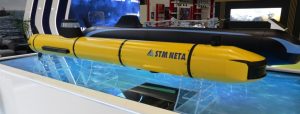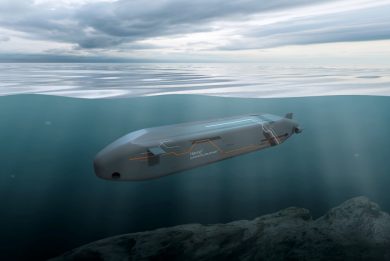SAHA Expo 2024 – STM unveils the first members of its Neta family of Unmanned Underwater Vehicles
At SAHA Expo, the defence exhibition taking place in Istanbul, STM unveiled the first two members of its family of Unmanned Underwater Vehicles (UUVs), the Neta 300 and the Neta 1000
“STM is a leading defence company in Turkey in the construction of surface ships and submarines and is the only national company involved in submarine design, construction, and modernization. Focusing on the undersea domain, company policy makers decided to start working in that niche area which is autonomous underwater systems,” Gürkan Gezgin, STM Industrial Cooperation Manager, a former Turkish Navy submarine officer himself told EDR On-Line.
“We initiated this development project in June 2023, the intention being to provide our customer, the Turkish Navy, a proven solution. We noticed that the mine fleet of our Navy is expecting new autonomous underwater devices for mine hunting, so we decided to start our development project looking at the MCM mission,” he explains.
The smaller UUV model exhibited is that of the NETA 300. The real system is 2.7 metres long, has a 205 mm diameter and weighs 70 kg with a single battery pack and 85 kg with two packs. Each battery pack has a capacity of 2.1 kWh, the one-battery solution ensuring a 12-hour endurance, which doubles when adding the second pack. The 300 in the product name indicates the maximum depth, in this case 300 metres.
The NETA 300 has a nominal speed of 3 knots, while dash speed is 5 knots. Navigation is provided by an inertial platform, a Doppler Velocity Log a GPS and an altimeter. An acoustic modem and a Wi-Fi are provided as standard communication systems, Iridium, RF Modem and LTE Modem being available as options. The NETA 300 body is in marine grade aluminium. Propulsion is provided by a direct drive DC brushless motor driving a three-blade propeller, fins ensuring course control. A 1 Gbit Ethernet interface as well as a plug for external battery recharging are available. STM also provides mission planning and mission debriefing software.
The bigger NETA 1000 is 5.4 metres long with a body diameter of 324 mm and a maximum mass of 360 kg. It has the same cruise speed, however dash speed is increased to 8 knots. The propulsion system maintains the same architecture, although it is obviously more powerful, the 10 kWh battery pack and SAS ensuring a 32 hours endurance. This increases to 55 hours when a 20 kWh and SAS is installed.
STM proposes similar types of payloads for both systems, among which we find synthetic aperture sonar, forward looking sonar, high-definition camera and led illumination, light sound velocity probe, as well as pressure and temperature sensors. The NETA 1000 is also provided with a software development kit to allow integration of third-party tools and payloads. While Mr. Gezgin underlined how the company is currently focusing on the MCM mission, the NETA family UUVs will be able be used for many other roles, such as search and rescue, intelligence, surveillance and reconnaissance, rapid environmental assessment, anti-submarine warfare, explosive ordnance disposal, port security, not to mention missions not strictly related to the military world. A grey area is the protection of submarine cables and pipelines, not strictly military but with strategic implications, and this is another domain that STM is considering for its NETA UUVs.
EDR On-Line understood that a lightweight NETA 100 for shallow waters operations as well as a NETA 600 are already under development, and that one of them should be unveiled in 2025. “We plan to contribute all of these missions, as our systems are modular, hence it is just a question of changing the payload,” the STM representative told EDR On-Line. “This is our vision, however we do not intend to limit ourselves to these UUVs, as we also want to become players in the Extra Large UUV domain,” he added, “once we will have acquired the necessary knowledge and experience,” an XL UUV being expected in one- or two-years’ time.
Talking about the two models seen at SAHA Expo, “the NETA 300 is almost proven and will start sea trials before year end, while the NETA 1000 is under development,” Gürkan Gezgin explained.
While the naval side of the project is relatively easy for a company with submarine experience, the key element in UUVs is the autonomy, and STM has in house specialists that are developing autonomy algorithms, which involve artificial intelligence to make the UUV capable to deal with unexpected situations, new capabilities being added following a spiral approach. And those developments will be key for that of the XL UUV, a category that sees 10-12 tonnes boats with a 10-15 metres length and a 1.2 to 1.5 metres diameter, capable to sail on distances between 1,000 and 2,000 nautical miles. Looking ahead 10-20 years these XL UUVs will become more and more common and submarine fleet will find a balance between manned and unmanned underwater platforms, according to STM, cost being one of the drivers.
Asked about autonomous XL UUVs capable to deliver for example Special Forces detachments Mr. Gezgin underlined that this will very much depend on how much we will trust AI-based systems. Which might be one thing for swimmer delivery vehicles, but it might be a wholly different case for weaponised systems.
All the work on UUVs is done in close cooperation with the national customer, which does not mean that the company is not looking at the export market. “Once we will have a proven product, we will obviously start marketing it in our friendly countries,” Gürkan Gezgin concluded, adding that in 2025 STM counts deploying its NETA 300 at the REP(MUS), the NATO annual experimentation exercise for unmanned maritime systems.
Photos by P. Valpolini









